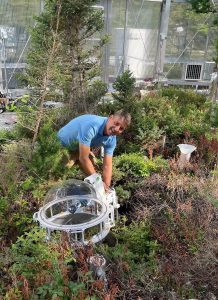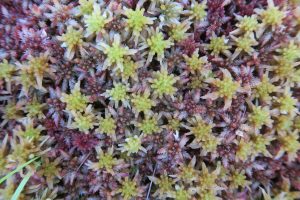by: Sarah Sharman, PhD, Science writer
Researchers at Duke University, HudsonAlpha Institute for Biotechnology, and Oak Ridge National Laboratory were part of a team that identified sex chromosomes in Sphagnum moss species. Since the sex of peat bog mosses alters carbon storage dynamics, this information could help protect Sphagnum and reduce the likelihood of peat bogs becoming major carbon sources.
Our planet is hotter now than ever in recorded history, with no indication of cooling down. The earth’s atmosphere protects the planet from too much light and heat from the sun while simultaneously holding in enough heat to sustain life. This atmospheric blanket is a delicate balance of several gasses, including nitrogen, oxygen, and carbon dioxide.
Since the 1800s, human activities, primarily the widespread use of coal and fossil fuels for electricity, heat, and transportation, emitted high levels of greenhouse gases that disrupted the atmosphere’s gas composition. Carbon dioxide is the main greenhouse gas culprit. Too much carbon dioxide in the atmosphere changes it from a protective blanket to a stifling greenhouse, trapping heat and slowly raising the earth’s temperature.
Earth’s temperature has increased in symphony with our increased reliance on fossil fuel-based energy. There is a major push to halt or reverse global warming by reducing human-produced greenhouse gas emissions. However, there is another, lesser-known, battlefield in the fight to save our climate: peat bogs.
Peat bogs: Nature’s carbon sink
Plants are tiny carbon-fixing factories. They take in carbon dioxide (CO2), release oxygen through photosynthesis, and store carbon in their trunks and leaves. However, their net contribution to carbon assimilation is not long-lived. When parts of the plant die, soil microbes decompose the leaves and other organic matter, releasing carbon dioxide into the atmosphere. Some environments, like grasslands and, to a greater degree, peat bogs, are far better at long-term carbon storage due to the reduced decomposition of dead plant material.

Dave Weston, PhD, at DOE SPRUCE whole-ecosystem manipulation experiment in northern Minnesota. Credit: Kyle Pearson/ORNL, U.S. Dept. of Energy
Peat bogs (also called peatlands) are marshy, wetland areas that make up about three percent of the earth’s land mass but store twice as much carbon as all the trees on the planet, aptly earning them the moniker ‘carbon sink.’ They form over tens of thousands of years in areas that cannot properly drain excess water. Debris from dead plants living in the bogs slowly accumulates in these soggy environments. The oxygen- and nutrient-poor, acidic soil in bogs drastically slows the decay of organic matter. Throughout history, many well-preserved items have been found in peat bogs, including wooden and bronze vessels, weapons, large chunks of butter, and perhaps most fascinating, mummified human bodies. ‘Bog bodies,’ as they’ve come to be known, are ancient human remains so well preserved that they look like modern victims rather than thousand-year-old mummies.
When bogs prevent plants from fully decomposing, the carbon within the plant tissue remains and is not returned to the atmosphere. The slowly decaying plant matter builds up in the bogs over thousands of years, forming a highly compacted, carbon-rich material called peat. Historically, peat was harvested for use as fuel. Several countries still rely on peat for heating purposes, but because of its low carbon content, it is a carbon-inefficient fuel source. Today, peat is most often harvested and used as a substrate in agriculture and gardening to improve the growth and productivity of plants.
One of the most critical environmental impacts of harvesting peat moss is the release of underground carbon stores into the atmosphere as carbon dioxide and methane. Five percent of our annual greenhouse gas emissions are estimated to come from the millions of acres of harvested peatland. In addition to human activities decimating peat bogs, the warming climate also dries up the bogs and impacts the very plant life that produces peat.
“Although boreal peatlands are a tiny three percent blip on the world map, they are more important to our environmental crisis than most people are aware,” says Dave Weston, PhD, a senior scientist at the Oak Ridge National Laboratory, working on the Spruce and Peatland Responses Under Changing Environments experiment (SPRUCE). “Experiments undertaken through SPRUCE show us different futures based on varying levels of temperature increase and CO2 concentration reduce Sphagnum mortality. We do not want a future where the peat bogs become a carbon source instead of a carbon sink.”
Sphagnum mosses are a keystone species in peat bog ecosystems
In addition to providing the plant material to create peat, several plants also do double duty and help create and maintain the perfect boggy environment for peat production. Sphagnum mosses are one such fundamental member of the peat bog ecosystem. There are nearly 400 different Sphagnum species. They can hold up to 20 times their dry weight in water, making them the perfect ground cover to keep peat bogs soggy. The mosses also engineer hyperacidic conditions and low oxygen levels that contribute to slow decomposition rates and prevent microbes or other organisms from feeding on the peat and releasing carbon.
Peat accumulation within bogs is primarily linked to moss growth, biomass deposition, and low decomposition rates. Researchers with the SPRUCE project determined that mosses lose productivity and die more quickly in hot temperatures. Without the mosses insulating the bogs, carbon can leach from the soil into the atmosphere. Understanding how mosses create and maintain the ideal bog conditions could be critical for preserving our current bogs and reducing the risk that bog carbon sinks become carbon sources.
Researchers at the HudsonAlpha Institute for Biotechnology, Oak Ridge National Laboratory, the Department of Energy Joint Genome Institute, and Duke University recently revealed results from a study published in Nature Plants that brings them closer to understanding the moss’s unique biology in hopes of protecting these fragile ecosystems in the midst of climate change. To help understand the genetic basis for Sphagnum carbon sequestration and ecosystem engineering, a group of researchers at the HudsonAlpha Genome Sequencing Center, led by Adam Healey, PhD, produced high-quality reference genomes for two Sphagnum species: S. divinum and S. angustifolium.
They produced the most contiguous (complete) non-vascular plant genomes to date. Interestingly, because Sphagnum diverged from other mosses millions of years ago, there is no conserved gene order, or synteny, between Sphagnum and other mosses. In fact, Sphagnum has no synteny with any vascular land plant the researchers compared it to either.
“Normally, when we conduct genomic research, we compare our data to other closely related organisms that have been sequenced to help guide analysis and interpret results,” says Healey. “This isn’t possible with Sphagnum because of how diverged they are from anything else we have worked with.”
Genetics help male Sphagnum mosses survive stressful conditions
When the team looked at the new moss genomes, something else stood out: they each had one tiny chromosome, about one-quarter the size of the other chromosomes. In other plant and animal systems, sex chromosomes are often characterized by their smaller size and lack of recombination with other chromosomes. The bite-sized chromosomes had both characteristics, but verifying they were sex chromosomes proved difficult.
“Sphagnum mosses do not express sex in a laboratory setting,” says Duke University professor of biology, Jon Shaw, PhD. “Luckily, a graduate student from my lab took impeccable notes during our initial field collection of some of the mosses from which we have DNA samples. Attributing female or male sex to the genome sequences allowed the team to definitively determine that Sphagnum has a U/V chromosome sex determination system.”
This study reports the first Sphagnum moss sex chromosomes to be identified, which are also the smallest sex chromosomes observed in nature. Through a series of experiments, the team determined that the sex of Sphagnum is linked to its growth in peat bogs and how it contends with its acidic environment. In males, interactions between sex chromosomes and genetic variation on non-sex chromosomes allowed some males to grow better under stressful pH environments.
“Sphagnum growth under these acidic peat bog conditions is inextricably linked to the sex of the plant and how they contend with abiotic stresses that they impose on themselves,” says Healey. “Understanding the interaction between sex, growth, and environmental stress is critical for ascertaining the complex role that Sphagnum plays in these peatland ecosystems and how to keep these populations robust and healthy when faced with a rapidly changing environment.”
Healey, A.L., Piatkowski, B., Lovell, J.T. et al. Newly identified sex chromosomes in the Sphagnum (peat moss) genome alter carbon sequestration and ecosystem dynamics. Nat. Plants (2023). https://doi.org/10.1038/s41477-022-01333-5
Media Contact:
Emily Adelman
(256) 937-8210
eadelman@hudsonalpha.org



